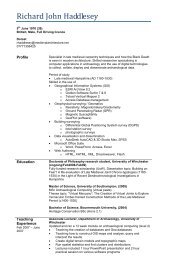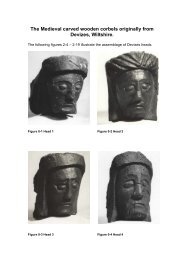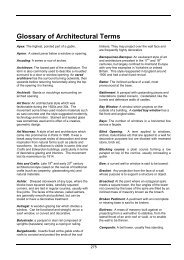The ARCHAEOLOGIST - English Late-Medieval timber-framed ...
The ARCHAEOLOGIST - English Late-Medieval timber-framed ...
The ARCHAEOLOGIST - English Late-Medieval timber-framed ...
You also want an ePaper? Increase the reach of your titles
YUMPU automatically turns print PDFs into web optimized ePapers that Google loves.
Imported pottery found in ports: a<br />
range from Southampton dating to the<br />
late 15th century. Low Countries tripod<br />
cooking pot, north Italian maiolica jug,<br />
jug in Beauvais double-slipped sgraffito,<br />
Saintonge chafing dish, Florentine<br />
maiolica dish, Raeren stoneware beer<br />
mug, cup in Tudor Green ware,<br />
Beauvais green-glazed dish and a bowl<br />
in Valencian lustreware. Photograph:<br />
John Lawrence © Southampton City<br />
Museums, Southampton City Council<br />
Imported pottery found inland: a<br />
discarded assemblage from Oxford,<br />
dating to the early 17th century. Anglo-<br />
Netherlandish dish, Rhenish stoneware<br />
beer mug, tankard and a rare flagon<br />
with ‘cut glass’ decoration, Surrey<br />
Border wares for serving at table, a north<br />
Italian Ligurian maiolica bowl and the<br />
neck of a Rhenish stoneware flagon.<br />
Ligurian products are almost unknown<br />
from excavations away from ports.<br />
Photograph: Jane Inskipp and Anne Holly<br />
© Maureen Mellor and University of<br />
Oxford, Ashmolean Museum<br />
<strong>Medieval</strong> pottery – Europe-wide<br />
Clive Orton<br />
A principal recommendation of the Mellor Report (<strong>Medieval</strong> Ceramic Studies<br />
in England: a review for <strong>English</strong> Heritage 1994) was ‘to establish a national list<br />
of production centres, recording the whereabouts of the finds, references to<br />
publications, or the current state of work’. A project to do just that was set up<br />
at King Alfred’s College Winchester (now University of Winchester), designed<br />
and managed by Chris Gerrard, undertaken by Phil Marter and funded by<br />
<strong>English</strong> Heritage. For details see http://www2.winchester.ac.uk/mppc/.<br />
Working across Europe<br />
This project aroused much interest, not only in<br />
England but across Europe, and it was felt that,<br />
since ceramics do not respect national boundaries,<br />
a similar project on a pan-European scale would<br />
be extremely useful. A working party was<br />
inaugurated at the European Association of<br />
Archaeologists conference in St Petersburg (2003),<br />
followed by round-tables in Lyon (2004), Cork (2005)<br />
and hopefully Krakow (2006). A workshop in<br />
Oxford in 2005, with participants from 15 countries,<br />
agreed the structure of a research design for the<br />
project.<br />
<strong>The</strong> Consortium furthering the project is led by the<br />
<strong>Medieval</strong> Pottery Research Group under the aegis<br />
of the European Association of Archaeologists,<br />
and includes UCL Institute of Archaeology and<br />
the Institute of Archaeology, University of Oxford.<br />
I submitted a bid to the EU’s eContentplus<br />
programme for a two-year project, Ceramic Production<br />
Centres in Europe (CPCE). Belgium, England, France,<br />
Germany, Ireland, Italy, Poland, Scotland and Wales<br />
are partners in the bid, and Albania, Denmark,<br />
Estonia, Greece, Hungary, the Netherlands, Portugal,<br />
Romania, Russia, and Spain have expressed interest<br />
and may join later if the bid is successful.<br />
This was my first experience of bidding for EU<br />
money, and not one that I would like to repeat. As<br />
well as a large master application, I coordinated<br />
partners in each country completing their paperwork.<br />
A blank box anywhere would have meant instant<br />
rejection for the entire project, and some potential<br />
partners had to withdraw because they could not get<br />
their information together in time. <strong>The</strong>y will be able<br />
to join later, but without EU funding.<br />
Five-language database<br />
<strong>The</strong> aim is to create a five-language (<strong>English</strong>,<br />
French, German, Italian and Spanish) web-based<br />
database of pottery production centres across<br />
Europe, for AD 400 to 2000, linked to a suite of<br />
maps. <strong>The</strong> data will be extracted from records held<br />
digitally across Europe, with limited new collection<br />
to fill gaps. <strong>The</strong>y will be entered into a field<br />
structure already established and tested in England.<br />
This prototype format provides a research resource<br />
of pottery production from domestic to industrial,<br />
and by expanding the geographical spread it will<br />
log the distribution of similar products on a Europewide<br />
canvas, and thereby chart continent-wide<br />
historic patterns of trade, as well as of crafts people,<br />
techniques and ideas. <strong>The</strong> database will be<br />
illuminated by country-specific narrative texts,<br />
highlighting recent discoveries and research.<br />
and pottery thesaurus<br />
Data-collection will create one research post in the UK<br />
(based in Oxford and managed from UCL), and one<br />
in each partner country. <strong>The</strong> data structure is openended,<br />
so the project can offer a welcome to new<br />
partners. A secondary but vital objective is to create a<br />
five-language thesaurus of archaeological ceramic<br />
terms relating to production centres. <strong>The</strong> resource will<br />
be aimed at social and economic historians, students<br />
and teachers of design and technology, practising<br />
potters, collectors, arts professionals, social scientists<br />
and the informed public, as well as the core audiences<br />
of archaeologists.<br />
Clive Orton<br />
Professor of Quantitative Archaeology<br />
UCL Institute of Archaeology<br />
31–34 Gordon Square, London WC1H 0PY<br />
c.orton@ucl.ac.uk<br />
Delegates at the Oxford<br />
workshop 2005: Thanasis<br />
Vionis (Greece), Koen<br />
Degroote (Flanders), Marta<br />
Caroscio (Italy), Elvana<br />
Metalla (Albania) and Dries<br />
Tys (Belgium). Photograph:<br />
Marta Caroscio<br />
Partner countries (dark shading)<br />
and prospective partners (light<br />
shading) (map courtesy of<br />
www.enchantedlearning.com)<br />
46<br />
<strong>The</strong> Archaeologist<br />
Summer 2006 Number 60<br />
47





